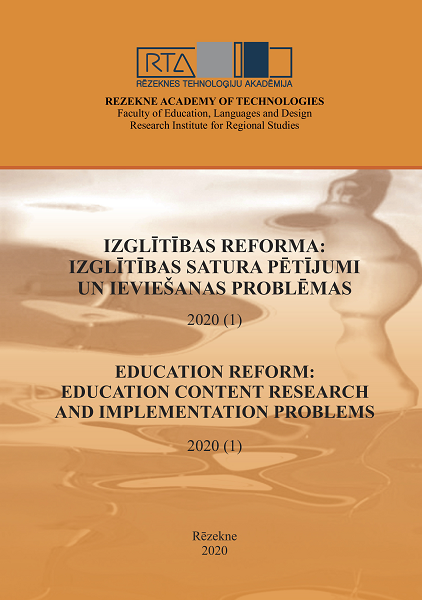ACTIVITY OF YOUNG PEOPLE WITH DISABILITIES IN THE DIGITAL ENVIRONMENT
DOI:
https://doi.org/10.17770/er2020.1.5195Keywords:
young people with disabilities, digital technologies, activity in the digital environmentAbstract
Young people with disabilities are often socially inactive because their participation in social and economic processes is limited. In order to reduce this, digital technologies are important, the use of which allows any individual to engage in various types of activities (educational, cultural, economic, etc.).
Objective of the paper: to analyze the results of exploratory research on the activity of young people with disabilities in the digital environment. Methods: questionnaire, focus discussion.
The results suggest that support and education measures require a differentiated approach, in which it is important to determine the level of interests and digital competence of each young person with disabilities, clearly set goals that can be adapted to individual needs, tasks according to individual abilities/skills. This means working in small groups or individually.
References
Balandin, S., & Molka-Danielsen, J. (2015). Teachers’ perceptions of virtual worlds as a medium for social inclusion for adults with intellectual disability. Disability & Rehabilitation, 37, 1543-50. doi: 10.3109/09638288.2015.1052574
Boitmane, I. (2019). Invalīdu profesionālā iesaiste sociālo mediju platformās. Retrieved from http://www.siva.gov.lv/tl_files/foto/koledza/Zinatniska_konference-2019/2_Boitmane_Iesaiste-soc-med-platformas.pdf
Brunner, M., Palmer, S., Togher, L., & Dann, S. (2019). “If I knew what I was doing on Twitter then I would use it more”: Twitter experiences and networks of people with traumatic brain injury (TBI). Brain Impairment. DOI: https://doi.org/10.1017/BrImp.2019.12
Centrālā statistikas pārvalde (2019). Iedzīvotāju skaits republikas pilsētās, novadu pilsētās un novados. Retrieved from https://www.csb.gov.lv/lv/statistika/statistikas-temas/ iedzivotaji/iedzivotaju-skaits/galvenie-raditaji/iedzivotaju-skaits-republikas-pilsetas
Forrester-Jones, R., Jones, S., Heason, S., & Di'Terlizzi, M. (2004). Supported Employment: A Route to Social Networks. Journal of Applied Research in Intellectual Disabilities, 17(3), 199–208. https://doi.org/10.1111/j.1468-3148.2004.00199.x
García-Betances, R. I., Cabrera-Umpiérrez, M. F., Ottaviano, M., Pastorino, M., & Arredondo, M. T. (2016). Parametric cognitive modeling of information and computer technology usage by people with aging- and disability-derived functional impairments. Sensors (Basel, Switzerland), 16(2), 266. DOI: https://doi.org/10.3390/s16020266
Hemsley, B., Balandin, S., Palmer, S., & Dann, S. (2017). A call for innovative social media research in the field of augmentative and alternative communication. Augmentative and Alternative Communication, 33(1), 14-22. DOI: 10.1080/07434618.2016.1273386
Koskentausta, T., Iivanainen, M., & Almqvist, F. (2007). Risk factors for psychiatric disturbance in children with intellectual disability. Journal of Intellectual Disability Research, 51, 43–53. DOI: 10.1111/j.1365-2788.2006.00871.x
Labklājības Ministrija (2019). VDEĀVK uzskaitē esošās pilngadīgās personas ar invaliditāti pēc invaliditātes smaguma pakāpes un administratīvās teritorijas. Retrieved from https://data.gov.lv/dati/lv/dataset/vdeavk-pilngad-pers-ar-invaliditati
Luo, N., Zhang, M., & Liu, W. (2015). The effects of value co-creation practices on building harmonious brand community and achieving brand loyalty on social media in China. Computers in Human Behavior, 48, 492-499. DOI: https://doi.org/10.1016/ j.chb.2015.02.020
Media Access Australia (2012). Sociability: Social media for people with a disability. Media Access Australia. Retrieved from http://www.mediaaccess.org.au/web/social-media-forpeople-with-a-disability
Paterson, H., & Carpenter, C. (2015). Using different methods to communicate: how adults with severe acquired communication difficulties make decisions about the communication methods they use and how they experience them. Disability & Rehabilitation, 37, 1522 -1530. doi:10.3109/09638288.2015.1052575
Raghavendra, P., Newman, L., Grace E., & Wood, D. (2015). Enhancing social participation in young people with communication disabilities living in rural Australia: outcomes of a home-based intervention for using social media. Disability and Rehabilitation, Volume 37, Issue 17: Special Issue: Social Media and Communication. https://doi.org/10.3109/09638288.2015.1052578
Stendahl, K., & Balandin, S. (2015). Virtual worlds for people with autism spectrum disorder: A case study in Second Life. Disability & Rehabilitation, 37, 1591-1598. doi:10.3109/09638288.2015.1052577
Wang, Y., Min, Q., & Han, S. (2016). Understanding the effects of trust and risk on individual behavior toward social media platforms: A meta-analysis of the empirical evidence. Computers in Human Behavior, 56, 34-44. DOI: https://doi.org/10.1016/ j.chb.2015.11.011
Wang, W., Wu, Y., Yuan, C., Xiong, H., & Liu, W. (2017). Use of Social Media in Uncovering Information Services for People with Disabilities in China. International Review of Research in Open and Distributed Learning. Special Issue: Advances in Research on Social Networking in Open and Distributed Learning, Volume 18, Number 1. Retrieved from https://www.erudit.org/en/journals/irrodl/1900-v1-n1-irrodl05016/1066179ar.pdf






